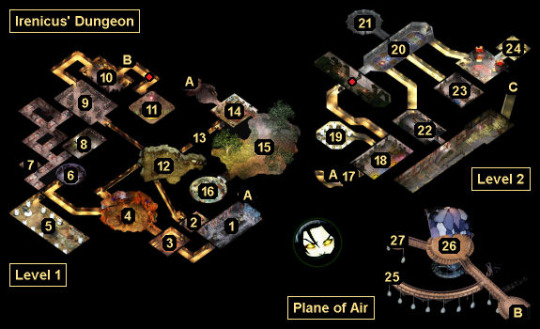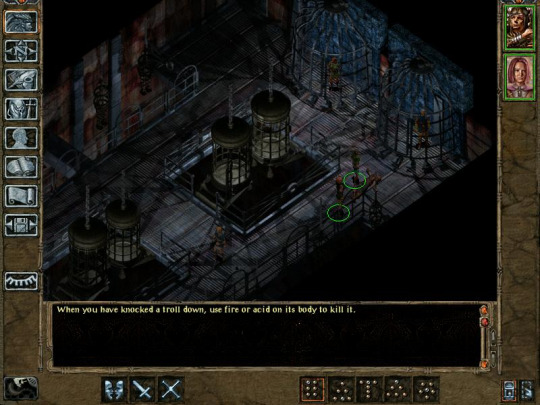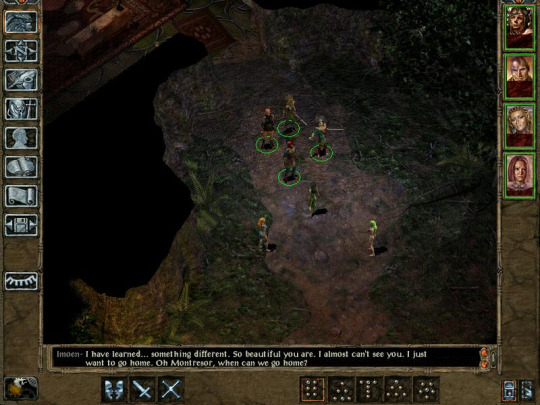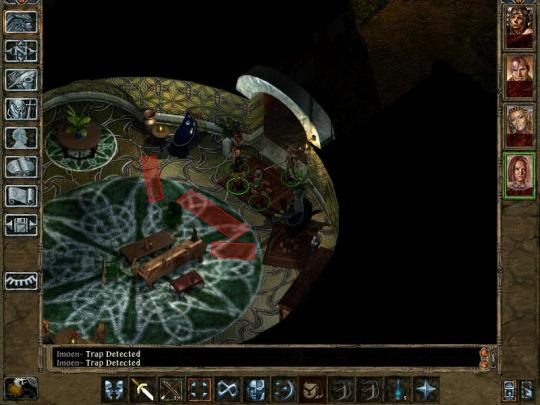#planescape torme
Text
Blast from the Past: Baldur’s Gate 2 Tutorial
Ok so last time I talked about Bladur’s Gate I’s Candlekeep and how it is my standard for what an RPG tutorial should be. Today I want to switch things up and talk about a tutorial which I am more mixed about, which is both good and bad, Jon Irenicus dungeon from Baldur’s Gate II
See in many ways I think this is a fantastic tutorial, it has story, it has character, it has challenge, it introduces the characters and it is related to the plot, what more could you want? Well...it has one big problem and that problem kinda....kills it even though it is great
So ok, the premise is this. After emerging victorious in BG1, you guys wander off and are captured and you wake up basically being experimented on in a laboratory by a freakishly powerful mage named Jon Irenicus. The mage speaks to you in this creepy dispassionate way where it is clear he doesn’t even see you as human, and the whole place feels cold and distant. He gets attacked by enemies and has to leave, giving you an opportunity to escape, and this is his dungeon. So lets talk about what this does well and oh so well before we get to the glaring error
1) its a pretty interesting dungeon. You are going through what is a tutorial dungeon but rather than fighting a bunch of goblins and rats in the most generic caves ever, you are going through a place with a unique antithetic with a bunch of cool monsters. Over the course of this adventure you will run into clay Golems, Mephits, Grey Dwarves, Shadow Thieves, Jinn, air elementals, Ogres Mages, Rakasha, Cambions, Demons, Otyugh, some deranged clones, goblins, some enslaved Nymphs, a Vampire, a doppleganger, and a ton of traps. Its a whole variety of different D&D creatures all of whom have a place in the dungeon (except the goblins why are they here?) and many have different methods of interaction. At one point you go to the Plane of Air, and an underground forest and this is all just in the first dungeon. Compare this to like the opening dungeon to Oblivion.

2) it serves a lot of story functions, which I am going to sub divide
2a) It builds the Character of Irenicus, actually more so than the rest of the game. The entire place feels cold, sterile, and kinda...in human. The clone rooms, the experiment labs and of course the terrifying room, it really does feel like somebody who has lost all ability to feel but remembers he once did. Its really creepy and is able to convey a lot about him that talking to him will not. The way Imoen is so broken reflect this as well

(This character has dignity..no really)
2b) It advances the plot, two of your companions die here, though I never liked that plot line. more importantly though, it shows off the varied world of D&D and how much Baldur’s gate is going to engage in the more exotic elements of the D&D world
2c) It is the only time in the entire saga where you really feel helpless, when I first played I was terrified Jon would find me (I was 10 btw) and this entire area always creeped me out. This is your lowest point

(eww)
3) And this is absolutely critical, this dungeon is actually pretty tough...or it would be if you weren’t stronger. If you entered this dungeon at almost any point in Baldur’s Gate 1, this place would kick your ass but here...its kinda easy. Its basically a starter dungeon, except that everything in this is powerful but you are more powerful. Its a great introduction to mid level play and the possibilities that it offers. Through this dungeon it sets the tone for BGII vs. BGI, now you are actually able to handle yourself and you are going to be having more focused more specific adventures against much tougher opponents. Rather than design a tutorial dungeon, they designed a normal dungeon and then made the party higher level for it. You even find the sword of the main villain of the first game, just to hammer home how far you have come.

(We finally made it to a cage...)
4) Finally it has variance, some encounters are social, puzzles, traps, combat, stealth, different types of fight and you have some limited control of how to play it

Ok so far so good...what could be wrong?
Well....replay value. This dungeon is great the first time you play it, or if you play again after a long time. The second time though or the third time...this gets old real quick. you can’t just skip through it and there is enough XP and money in here that you want to stay to get it, which makes repeat play thoughs frustrating as you try to go through to get all the shit in here. Its so bad that there is mod to just skip this dungeon, even though it is pretty good in my mind.

Next up my favorite RPG tutorial level, a place with the architectural charm of a pregnant spider

#Blast from the past#Baldur's Gate#Baldur's Gate II#Forgotten Realms#RPG#Dungeons and Dragons#Roleplaying Games#Game Design#Tutorials#pathfinder: kingmaker#jon irenicus#Bhaalshawpn#Charname#planescape torme#Fantasy#D&D
34 notes
·
View notes
Text
Conversion; Double it and add 3D10
Hey Pal! I’m back with another probably way too long story/question for you. I’m not sure if you’ve ever played in the 2E Dragonlance Setting but there are specific rules for if a divine type character came there from another campaign setting (Planescape is a good easy example, but really any method)
Basically, only the Gods of Krynn have any godly power in the world Krynn. No matter how devoted you are to Pelor or Heironeous or whomever, they aren’t here. Their gifts aren’t with you and you lose any ability to cast your heathen spells until you find a God of Krynn to devote yourself to.
Now it’s easy to look at Paladine (Charity, Redemption, Leadership, Law, and Light) and see him as an analog to Heironeous (Chivalry, Justice, Honor, War, Daring, Valor) so when the DM tells you that your powers won’t work until you pick a Krynn deity, You as a player might think "Okay well I’ll just follow this guy instead. He seems Lawful Good enough.“ And from a gameplay standpoint that’s kinda whatever, you erase the "DEITY” portion of your character sheet and write in something else. But from a roleplay or narrative perspective that seems really… Wrong?
I can kinda see it both ways. Like if you really want to help people and you need (or think you need) your powers to do that, it’s best not to waste time. You devote yourself fully to Paladine and once again you’re able to Lay On Hands to save people, cure diseases to save lots of people, detect evil and all that stuff. Heironeous would understand, after all part of The Heironean Code is Duty to the People.
Hoowweevvver..
Part of that code is also devotion to Heironeous himself, and something about your divine powers not working so you turn around and find someone else who will give you your “fix” really rubs me the wrong way.
Maybe in my head I’m thinking of past Paladins I’ve played and how completely devoted they were to the deific figure that changed their life, lifted them from the muck and gave (made) them (into) a shield to keep the rest of the world safe. But I have a hard time imagining a Paladin (or Cleric, for that matter) ending up in a different plane and visiting all the churches trying to find the one that is “Close Enough” to the deity that they devoted themselves to.
I used Heironeous as an example because off the top of my head I thought his and Paladines followers would be fairly compatible, but depending on the setting your characters come from, the choice might not be as easy. Now granted, this COULD lead to some absolutely amazing roleplay scenarios where you choose to follow a deity who has similar domains and encourages similar virtues but is incredibly different in one or two ways, especially if at some point you return to your other plane and have to confess your infidelity.
I’d be very interested to hear your thoughts on this kind of situation, I’m always happy to read your insights into things like this.
———————-
Hmm. If I were a paladin planetraveler who found himself in Krynn, unable to contact, say, Torm, Pelor, Iomedae, or Sarenrae, whichever I am pledged too, I think it would be a true test of faith to believe in something without any hint of its power. I understand why you’d feel that unease. No matter how similar, if I were to switch from my god to a god of a different universe as soon as my faith became inconvenient, or lacking definitive proof (much like how faith can be in reality) then what kind of believer am I? What Champion of Torm would I be if I discarded the Loyal Fury as soon as it became an issue?
But from a roleplaying perspective I can see why some devoted would seek another god in the absence of theirs. They come from worlds where the gods have a tangible effect on their lives, and to have them silenced would have no prior similar experience for them to acclimate. I can understand that. So they could seek out the gods of Krynn for an alternative.
Or, they can find ways to exemplify what they believe in in the absence of divine power. Live by the ideals they swore to, that faith can become a strength on its own. So much so that if they ever came home, they would be all the more powerful and devoted for it, a true paladin even in the face of silence.
9 notes
·
View notes